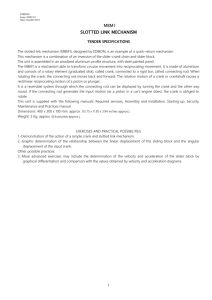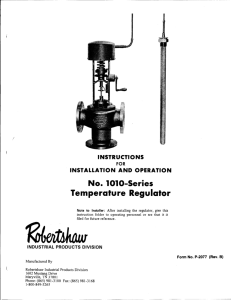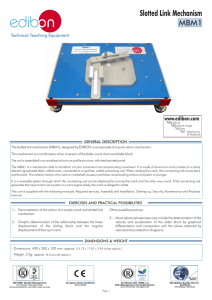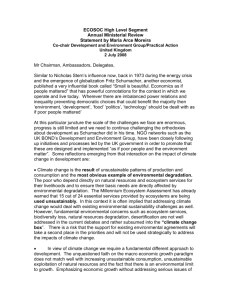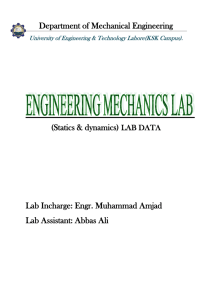THE EFFECT OF CRANK ARM ... ANAEROBIC POWER OF COMPETITVE CYCLISTS
advertisement
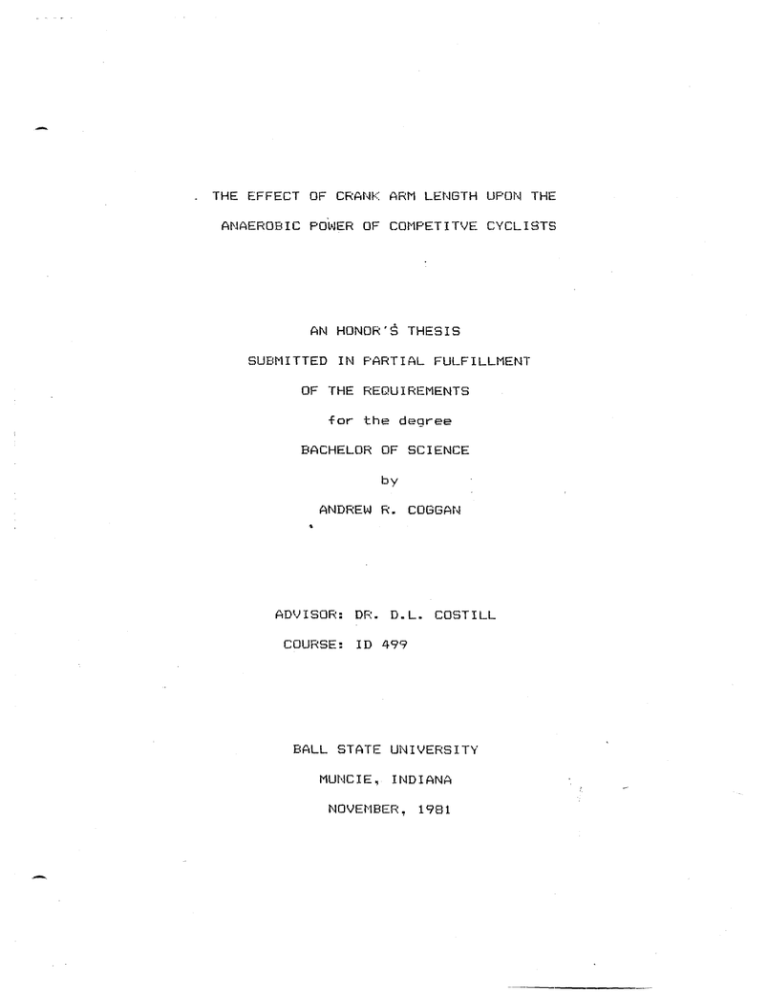
THE EFFECT OF CRANK ARM LENGTH UPON THE
ANAEROBIC POWER OF COMPETITVE CYCLISTS
AN HONOR'S THESIS
SUBMITTED IN PARTIAL FULFILLMENT
OF THE REQUIREMENTS
for the degree
BACHELOR OF SCIENCE
by
ANDREW R. COGGAN
ADVISOR: DR. D.L. COSTILL
COURSE: 10 499
BALL STATE UNIVERSITY
MUNCIE, INDIANA
NOVEr'1BER, 1981
-.
-
Intr-oduction
The cycle er-gometer- is widely used as an exer-cise
testing
and
mode
define the
in
devil:e
physiological
for- its
ideal conditions
r-esear-ch.
use, var-ious
resear-cher-s
pedalling
y-ate
(BanisteY- and Jackson 1967; Dickinson 1929; Hagbey-g et al.
1981;
attempted
have
SeabLlr- y
et
to
deter-mine
1977)
a I •
the
seat
height
(Noy-deen-SnydeY- 1977;
(1967)
Shennum and deVy-ies 1976). SimalaY-ily, Hamley and Thomas
and
Fay-ia et al.
postuY-e
on
(1978) have
sub rna 1; i ma I
e:/;i:wdned the effect
and
variables.
positioning on an
that has
effect
not been
the pedal
cy-ank ay-m.
include cy-ank
detey-mination of
(1982) and Goto
ay-m
length
the effect
E~t
er-gometeY-
oy-
extensive y-esear-ch
length of
of the
clf upper- body
al.
clf seat
ar-m
bicycle
is
thE'
Thomas (1967),
length
i
ovey- a I
t1
hE'ight. Cay-michael
et al.
(1982) hav+2- examined thE' effect of
cy-ank
on
vay-iables
but
this
been
The
i
nv~?-st
i gat i on,
thE'y-efoy-e~
was to
diffey-ent cy-ank ar-m lengths (160,
peak
exey-cise,
toy-que,
i.e., 45
examine
170,
second sprint
this
the effect
dur-ing
bouts on
by- i e f,
a cycle
competitive cyclists
study aftey- giving theiy-
of
180, and 190 mm) on
and fatiguability
Fouy- highly-tr-ained
this
pur-pose
mean
rna:·d rna I
ey-gometey-.
pay-ticipated
in
informed consent. Their- physical
characteristcs are
in Tab
shown
1.
It:"
was
.-,
det erreai tled
..::.
work
dur i tlg an
braked
ergometer using
cyclists had
test on
a
Collins
electrically-
an automated
gas analysis
road
experience,
extensive
racing
system.
AI I
competed regularly in track racing.
Testing was
cycle
Fitron
performed on
a modified
(90)
rpm
was
by a variable-orifice
measured
by
a Cybex
Corp.,N.Y.).
very narrow limits of
single
channel
efforts.
recorder by
incorporating a pressure potentiometer into the ergometer,
work was determined with a Cybex Digital
total
the
hydraulic valve, with
to the subject's
resistance variable and proportional
Torque
Lumex
Di v. ,
ergometer
Pedal ling rate was maintained within
selected
hydraulically-braked
while
Work Integrator.
The system was calibrated prior to al I testing with the input of
known torques. Repeated calibrations using this method indicated
variation in the
output
et a I.
determination of total
work
of 1.6%. This system has been described previously (Ivy
1979).
The Fitron cycle was equipped with racing-style handlebars,
saddle, and pedals with toe-clips and straps.
their cleated racing
from
shoes fOl' a I I
the subject's racing bicycles
height and
horizontal
relative to the pedal
position.
axle;
The cyclists wore
trials. Measurements
taken
were used to establish seat
AI I
measurements
were
made
thus leg extension was kept constant
throughout the range of crank arm lengths.
All
enci of
testing was conducted
the cyclist's
over a
competitive
four
week period at the
season. The
subject's
were
Table 1. Physical Characteristics of Subjects
Age
(years)
Years Competing
Mean
S.E.
Range
2-7.3
2.5
23-34
..,..
~
c-
1.3
2.5-9.0
"-"'.
Height
(cm)
181.3
1.8
178-183
ght
(kg)
69.8
4 ......
'')
60.2--72.2
4.72
0.06
4.65-5.20
68.3
4.2
66.8-80.2
WE~i
(L/min)
1'1aN VO
"
Ma}·{
-1
2
(ml/kg*min
VO
2
)
instructed
to maintain
and to refrain from
test.
At
least
exercise for the
hours
72
the
Ad d i t i on a I I y,
their training during
24 hours preceeding
intervened
of
order
al I
between
trials
was
for mean
test-retest correlation coefficient
this time period
each
trials.
al I
raridomized. The
power for
paired
trials in pilot work was r=0.91.
two trials
using
..
Each subject performed
lengths:
crank
180, and 190
160, 170,
the ergometer, the
subject was al lowed
approximately
va
50%
max.
After
a
each of the
mm. After adjustment of
five minutes warmup
one
minute
pause,
at
the
2
subjects began pedal ling
to
go
verbal
" a ll-c•u t" from
on command.
II
instructed
of
the test,
and strong
given to insure
a maximal
the beginning
encouragement was
"al I-out
Subjects were
pa.:i ng stra.tegy' has
work production during cycling
<Katch et
al.
was
to
used
1976),
calculate
percent fatiguability
curves (see
resul t
in greater
tasks 36-60 seconds in
work
production
during
mean power, while peak torque
were
determined
manually
from
duration
the
test
and
torque
analysis
of
significance.
variance
was
used
to
determine
Student-Newman-Keuls
A
analysis was employed to locate any significant differnces.
P=(:I. (:t5
An
Figure 1).
Two-way
statitcal
Tc.tal
been showti to
effort.
level
was
used
for
all
significance
The
testing.
Pesults
The 180 mm crank arms resulted in significantly higher mean
FIGURE 1
SCHEMATIC REPRESENTATION OF TORQUE CURVE
T
o
R
A
Q
U
B
E
~-----------45 SECONDS---------~
TIME
A
=
PEAK TORQUE
B
=
FINAL TORQUE
FATIGUABILITY (X)
= (1.00 - (B/A»
X 100X
-
power over the
crank
45 second
period when
compared to
length tested (see
arms, the shortest
the 160
mm
Table 2). No sig-
nificant differences existed, however, between the 160, 170, and
1 '30::'
.:r ank
raUII
arms or
betwe,en the 17(:',
making selection
18(',
1'30 film
and
length on the
.:rank arm
of an optimal
crank
basis of mean power alone difficult •.
The
,trial
peak torque
generated at
the very
was significantly greater for the
lengths
compared to the
torques for the
higher
180 and
than for
the 170
beginning of each
longest crank
th~ee
arm
160 mm crank
arms. Additionally, peak
1'30 mm crank
arms were
mm crank
significantly
arms. However,
account the length of the lever arm used to produce this torque,
the
calculated peak
force that would
a right
angle
to the
longest
crank
than
appro:.-;imatel y
Peak
pedal
for
the
decreased
other
the
roughly
three.
No
in
fatiguability
r~lationship
compared
subject's
50%
OVer
increasing
for
the
forces are
bo:odyweight.
the
45 second
non-significant,
crank
length.
was found between any of the variables when
with crank length
leg length or t.;:.tal
with
lE'sS
These
duration of the sprint, showing a general, but
,i ncr ease
be generated at
was significantly
three-fourths
to:orque
have to
expressed as a
percentage o:of upper
leg I "mgth.
DISCUSSION
Although no physiological data was obtained in this
data
from
eyc ling
several
task
was
sources
support
predominantly
the
assumption
anaerobic.
Inbar
study,
that the
et
al.
Table 2. Results Crank Length
(mm)
Mean±S.E.
160 _
170
180
576.5
589.6
601.6
586.7
+28.5
±17.0
±28.7
±26.6
86.5
91. 1
95.0
94.2
±5.2
:1:5. 1
:1::4.6
±.5.3
190
a
Mean Power
(watts)
a
Peak torque (n: IT!)
d
PE:ak force
(n)
Fatiguability
(%)
a,b
d
a,b
d
540.5
535.8
526.8
495.8
±32.5
±30.0
±25.6
±27.9
49.0
49.3
50.9
51. 5
±5.3
±6.1
±5.9
±6.5
--~--------------------------------------------------- ----------
a
Significantly greater than 160mm value
b
Significantly greater than 170mm value
c
Significantly greater than 180mm value
d
Significantly greater than 190mm value
(1976) have demonstrated that oxygen
cyc ling
Jacobs
tot
same
powt-r
Assuming
protocol.
in
output
the
vo
Thert-
energy
the
have
t-fficiency,
study
required
€;-videnc€;-
is
second
shown
ft-malt- subjt-cts
in
constant
prest-nt
of
(1982)
a I.
si!l;-fQld incrt-ast- in Tllusclt- . lactate
the
,:j I.
1 ,"\·,
only
represented
test
Sirld I ari I y,
requi red •
uptake during a 30
a
using
the
mean
approximately
t- f f i c i
that
tH1C y
2
dt-creases
as
r€;-~uirement
anaerobic metabolisM
increases, thus
the energy
is possibly €;-ven higher (Wojcieszak et al.
1981).
The subj€;-cts in the prest-nt study aVt-raged 588.6 watts
al I
trials. This
Katch et
similar
al.
tQ
is greatt-r than
(1976) during
tht-
than tht-
watts
578.6
for physical
(1981)
665.0 watts
(1981).
I€;-vel
st-cond
r€;-portt-d
dt-vt-loPt-d
watts reported by
ergometer
by
education students.
a 20 second isokint-tic
al.
a 60
the 488.3
tt-st,
Wojci€;-szak
It is
by untraint-d
cycling sprint
for
but
et al.
It-ss, however,
subjects
r€;-ported by
during
Sargt-ant tot
Thest- difft-renct-s art- probably due to tht- training
and t-xPt-rit-nce of the subjects, and/or the duration of the
wor k bOLd:;.
Th€;- linding that M€;-an power d€;-cr€;-ases with €;-xct-ssiv€;-Iy long
crank~::;
is
dt-Monstratt-d
vt-Iocityof
not
t-ven with
constant
the hip
and
crank
knee
length.
conSUMPtion also
cranks. As
maximal
GOtO
that
with incrt-asing
oxyg*n
surprising.
a result
forct- that
tot
pedal
Intt-9rate-d
(1982)
rpm?
joints incr€;-ase-s
EMG
have-
tht- angul <.\r
cur~alint-arly
I
activity
incr€;-ast- disprQPortionatt-ly
of this incrt-ast-d sPt-t-d
can be
al.
and
with long
of movemt-nt,
the
g€;-nerated is reduced (Sjoggard 1982)
Kaneko and Yamazaki
is
work
also increased
output
fatiguability has
of
movement
factors
excessively
with
(Sargeant at al.
s~all
power
Additionally,
with
higher
rates
and non-significant.
a crank
short of
arm is also
Despite equal or greater
apparent from the present data.
generated
reduce
1981), although the differences. in
using too
penalty for
to
ar-ms.
to increase
the present investigation were
The
combine
crank
long
shown
been
increases, reducing
limb velocity
as
these
of
All
efficiency.
mechanical
have shown that internal
(1982)
force
at the pedal, the peak torques resulting from the use
of 160 mm or 170 mm crank arms were significantly less than that
generated
the
with 180 mm and 190 mm crank arms, a direct result of
shorter
lever
Apparently
a
arm.
compromise
applied and the length
resulting
lo~ger
while
in peak
crank arms
shorter
ma:-: i mal
Hence,
between the
of the lever arm
power production.
result in
crank
arms
power
At a
not
force
reduced.
that
can be
is reached at 180
a decrease in
do
was
allow
mm,
constant pedal rpm,
the ma:·: i ma.l
maximum
force,
leverage.
The finding that the optimal length is longer than that
common
a.l.
use is quite different from the results of Carmichael et
(1982),
tar-ms
of
\"Jho
demonstrated that the
subma;.: i mal
efficiency
normally employed. Carmichael's
significant relationship
upper
leg length.
between
We have
lengths in
is
data
optimal crank leQgth
sr-torter
also
optimal
not observed
relationship, although this may
o·f leg
in
be due
than
indicate
crank
in
that
in
a
length
and
any such
to the
limited range
our subjects (89.2-93.5 cm).
-----_._-------
The finding that
work is not
th~
similar to the results
greater
work
length for
the optimal crank
for submaximal work is
most efficient
of Katch et al.
production
with
an
efficiency
are
who demonstrated
(1976),
cyc ling cadet1ce,
"all-out"
despite the reduced efficiency that results.
sub ma !/; i rna I
short-term
apparently
more
Factors other than
important
during
supramaximal work.
The present results indicate an• optimal crank arm length of
180
mm
rates may
for supramaximal
yield
dependent on the
More
research
stature
and
work at
different
velocity of
with
a
9·"
results,
rpm.
as
Different pedal ling
power
production
movement (Sargeant
wider range
of
subjects
et al.
in
is
1981 )
terms of
training status should be undertaken.
.,I
--------
Banister, E.W., Jackson, R.C.
(1967) The effect of speed and
load changes on oxygen intake for equivaleht power outputs
during bicycle ergometry.
Int. Z. Angew. Physiol. 24:284-290
Carmichael, J.K.S., Loomis, J.L., Hodgson, L.J.
(19~2) The
effect of cranklength on oxygen consumption and heart rate
when cycling at constant power output. Med. Sci. Sports Ex.
14:162
""
Dickinson, S.
(1929) The efficienl:y clf bicycl e pedal I ing as
affected by spe~d and load. J. Physiol. 67:242-255
Faria,
1.,
Di7~'
C., Frazer, C.
(1978) Effect ,;:.f b,:.dy
position during cycling on heart rate, pulmonary
ventilation, oxygen uptake, and work output. J. Sports Med.
18:49-56
Goto, 5., Toyoshima, S., Hoshikawa, T.
(1982) Study of the
integrated EMG of leg muscles during pedal ling at various
loads,
frequency,
and equivalent power.
IN: Paavo Komi
Ced.)
Biomechanics V-A. University Park Press, Baltimore,
Maryland, pp 246-252
Hagberg, J.r'!., Mull"in, J.P., Giese, M.D., Spitznagel, E.
Effect of pedal ling rate on submaximal
(981)
exercise responses of
competitive cyclists. J. Appl. Physiol. 51:447-451
Hamley, E.J., Thomas, V.
(1967) Physiicol,:,gical and pc.stural
factors in the calibration of the cycle ergometer.
J.
Physiol.: Proceedings of the Physiological
Society.
191:55-57p
It,bar, 0., D'::lbat"
F.:., Bar-Or, O. (1975) Aerobic and anaerobi,:
components of a thirty-second cycling task. Med. Sci. Sports
8:51
Ivy, J.L., Costi II, D.L., Fink, W.J., Lower, F.:.W.
(1979)
Influence of caffeine and carbohydrate feedings on endurance
performance. Med. Sci. Sports 11:5-11
Jacobs,
I., Bar-Or, 0., Karlsson, J., Dotan, R., Tesch, P.,
Kaiser, P.,
Inbar, O.
in females with 30-s
Ex.
(1983) Changes in muscle metabolites
~xhaustive
exercise. Med. Sci. Sports
14: 457-46()
Kaneko, M., Yamazaki, T.
velocity changes of
ergometer.
(1982)
th~
Internal
mechanical work due to
limb in working on a bicycle
IN: Paavo Komi
(ed.), Biomechanics V-A
University Park Press, Baltimore, Maryland, pp 85-92
Katch, V., Weltman, A., Traeger, L.
(1976) AI I-out versus
steady paced cycling strategies for maximal
work-output of
short-duration. Res. Q. 47:154-168
variation upon oxygen consumption and lowe~
limb kinematics.
Med. Sci. Sports 9:113-117
Sargeant, A.J., Hoinvil Ie, E., Young, A.
(1981) Maximum leg
force and power output during short-term dynamic exercise.
J. Appl. Physiol. 51:1175-1182
.A
Seabury, J.J., Adams,
w.e.,
•
(1977)
Ramey. M.R.
a
Influence of
pedal ling rate and power output on energy expenditure during
bicycle ergometry. Ergonomics 20:491-498
Shennum, P.L., deVries,
H.A.
(1976)
Th~
effect of saddle height
on oxygen consumption during bicycle ergometer work.
Med. Sci. Sports 8:119-121
Sjogaard, G.
..
(1982) Force-velocity curve for bicycle work.
Paavo K6mi
IN:
(ed.), Biomechanics V-A. University Park Press,
Baltimore, Maryland, pp 93-99
Thomas, V.
(1967) Sc i t:.·nt i fi c sett i ng of sadd Ie posi t i .;:.n.
8:12-13
Wojcieszak,
.•
I., Puchow, M.,
Zdanowicz, P., Mckiewicz, G.,
Bucka, J., Michael, E., Burke, E.
(1981) Ma:--;irnum pc,wer and
Biomechanics III-B. University Park Press, Baltimore,
Maryland, pp 363-369
